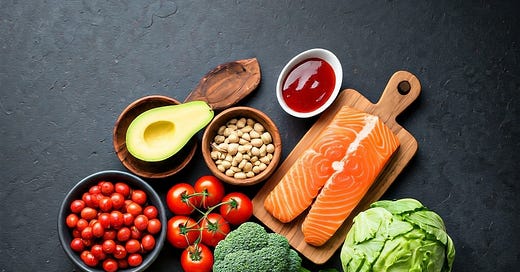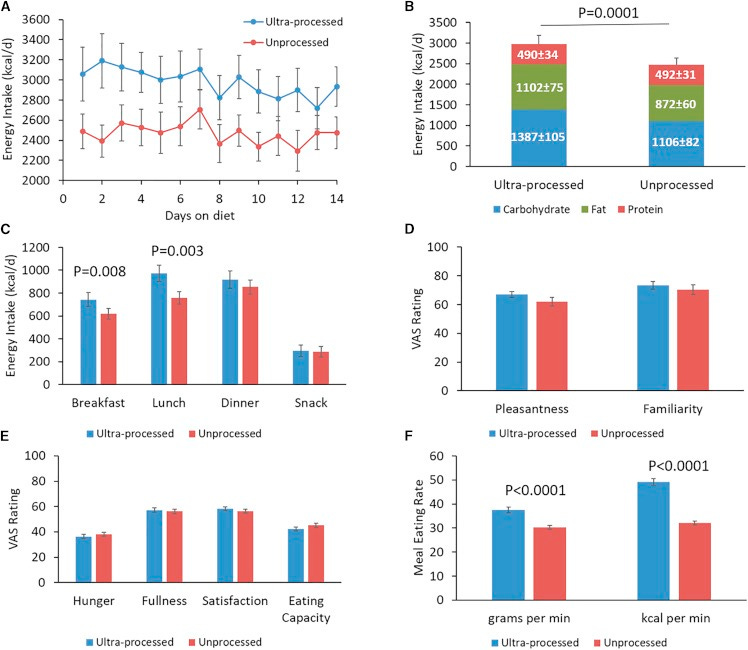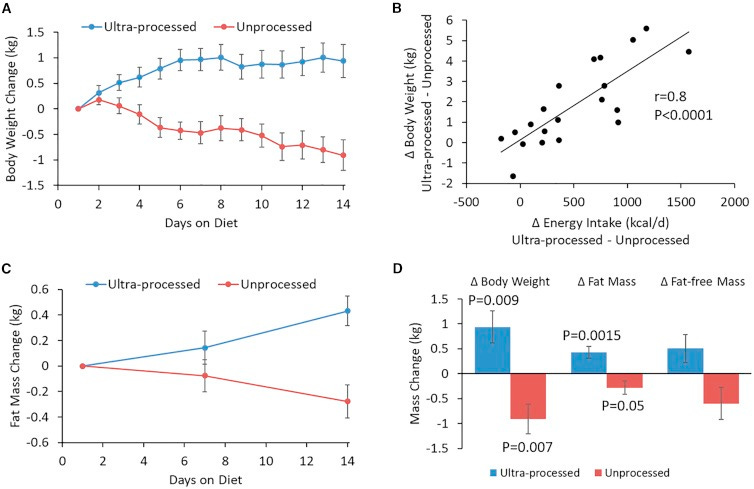I’ve been reflecting on my original intentions for starting this Substack. It occurred to me that I’ve covered some very niche, one might even say esoteric, research papers in many of these posts. I think (or at least hope) I’ve done a decent job of summarizing many of these papers, but I think what I could do a better job of is providing clear takeaway points.
I want to do a better job of not just covering what is this study about and what did they find? But also, what insights can I take from these findings? Or: how can this study inform my lifestyle?
With that in mind, for this wrap, I’ve done my best to select studies that address key aspects of each of the health categories I cover and at the end of each section I’ve included a takeaway point to highlight the insights that might help inform your lifestyle.
As always, I hope you learn something. Enjoy!
Sections
DIET | EXERCISE | SLEEP | STRESS | CONNECTION
Diet
Ultra-Processed Diets Cause Excess Calorie Intake and Weight Gain: An Inpatient Randomized Controlled Trial of Ad Libitum Food Intake | July 02, 2019 | https://doi.org/10.1016/j.cmet.2019.05.008
N = 20 weight-stable adults (aged (mean ± SE1) 31.2 ± 1.6 years; BMI = 27 ± 1.5)
Randomized Crossover Trial
To be honest, this is probably the most elegant diet study I’ve ever seen. High quality diet studies are difficult to come by because they’re hard to do. It’s hard to control what people eat for very long without a lot of logistical complications and/or expensive study design methods. The best diet studies are those that use an inpatient study-design, which allows for the highest level of control. Moreover, a crossover design is highly advantageous as well. This study used both of employed both of these design factors. For more information on these study design components, see this footnote.2
This study is honestly so rich. The experimentes put a lot of controls in place to ensure unbiased results and colleced a ton of data. I’ll do my best to summarize the key aspects and findings below with a mix of exerpts from the text, starting with this exerpt about the methods:
During each diet phase, the subjects were presented with three daily meals and were instructed to consume as much or as little as desired. Up to 60 min was allotted to consume each meal. Menus rotated on a 7-day schedule, and the meals were designed to be well matched across diets for total calories, energy density, macronutrients, fiber, sugars, and sodium, but widely differing in the percentage of calories derived from ultra-processed versus unprocessed foods (Table 1) as defined according to the NOVA classification scheme (Monteiro et al., 2018).
The two diets had significantly different effects on the eating patterns, weight, and biomarkers of the patients across the board. Importantly…
Participants did not report significant differences in the pleasantness … or familiarity … of the meals between the ultra-processed and unprocessed diets …This suggests that the observed energy intake differences were not due to greater palatability or familiarity of the ultra-processed diet.
On the ultra-processed diet, participants tended to consume more calories, consume calories at a higher rate, and gain weight over the course of the two weeks. Comparing the data from the second week of the diets, they found that while on the ultra-processed diet, participants consumed an average of 459 calories more per day. That’s a lot more calories. For references, that’s approximately the amount of calories there are in a McDonald’s Egg McMuffin combined with a McDonald’s hash browns.
Figure 3A illustrates that participants gained 0.9 ± 0.3 kg* (p = 0.009) during the ultra-processed diet and lost 0.9 ± 0.3 kg (p = 0.007) during the unprocessed diet. The individual differences in weight change between the diets were not significantly correlated with baseline BMI (r = 0.01; p = 0.97), but Figure 3B shows that they were highly correlated with energy intake differences between the diets (r = 0.8, p < 0.0001).
* 1 kg = 2.2 pounds
Takeaway: When we eat ultra-processed foods, we tend to over-eat and gain weight. Choosing to eat unprocesses, whole foods is perhaps the best strategy for improving the quality of your diet and losing weight.
Exercise
A Workplace Physical Activity Intervention and a Smartphone App for Overweight and Obese Sedentary Women | August 22, 2024
https://doi.org/10.1177/21650799241265131
N = 18 overweight and obese (body mass index [BMI] = 32.18 ± 4.48 kg/m2), adult (50.73 ± 8.76 years), female volunteers
Randomized Controlled Trial
“This study assessed the effectiveness of a free smartphone app with a goal-setting feature to increase physical activity (PA) and impact anthropometric, body mass (BM), and body composition (BC) changes among overweight and obese women within a community health workforce.”
The app used for the study is called StridekickTM. The nine participants assigned to the experimental group used the app set and track daily step goals with a “streak” feature to track the days-in-a-row that they reached their step goals. The other nine participants used the app to track their steps but without the “streak” feature. This group set their daily step goals outside of the app environment at the beginning of each week.
The results were honestly not impressive. Daily steps did increase from baseline, but the only body measure that significantly changed for both groups was a reduction in thigh circumference. Moreover, the “streak” feature of the app did not lead to more steps in the experimental group compared to the control group. Nevertheless, the app did seem to be effective at encouraging the participants to get more steps, and that’s a win.
Takeaway: If you want to get more physical activity, tracking it might help. You can get a fitness tracker, but you can also just use your phone to keep track of your steps, use apps to track your work-outs, or just keep track of your exercise in a notes app. I find keeping track of my exercise using a notes app motivating; seeing a long list of work-outs I’ve completed and adding to it feels intrinsically rewarding.

Sleep
This paper offers similar insights as to the sleep paper I covered in Wrap #12…
The Mind After Midnight: Nocturnal Wakefulness, Behavioral Dysregulation, and Psychopathology | March 2, 2022
https://doi.org/10.3389/fnetp.2021.830338
Review
This paper reviews prior research to present evidence about how being awake at night can lead to behavioral dysregulation and mental health issues. The authors propose the "Mind After Midnight" hypothesis, which suggests that nocturnal wakefulness leads to changes in attention, emotional regulation, reward processing, and executive function.
Key points:
Disruption of circadian rhythms, the body's natural clock that promotes wakefulness and cognition during the day and sleep at night, can increase the risk of psychiatric illness.
Nocturnal Wakefulness: Being awake during the biological night is associated with diminished cognitive capacity and mood regulation.
Increased Risky Behaviors: Nighttime is associated with an increase in impulsive and maladaptive behaviors such as suicide/self-harm, violent crime, substance use, and unhealthy food intake.
The risk of suicide is higher between midnight and 6 AM after adjusting for population wakefulness.
Violent crimes are more prevalent at night.
Substance use and cravings peak at night.
Unhealthy food choices and overeating are more common at night.
Brain Changes During Nocturnal Wakefulness:
Patterns of brain activity change throughout the day and night, which can have unintended consequences when coupled with nocturnal wakefulness.
Positive affect is lowest during the night, while negative affect is highest, which can lead to a negatively biased way of interpreting information when we stay up at night.
Reward processing is altered at night, and sleep deprivation can exaggerate the expectation of reward.
Executive functions such as working memory, problem-solving, and behavioral inhibition are diminished during nocturnal wakefulness and after sleep deprivation.
Takeaways:
Prioritize Sleep: Sufficient sleep with minimal interruptions during the night is crucial for daytime cognition and emotional regulation.
Maintain a Regular Sleep Schedule: Maintaining a consistent sleep schedule helps reinforce the proper functioning of our circadian rhythms and thereby improves our health and brain function.
Address Insomnia and Other Sleep Disruptions: Insomnia, nightmares, and circadian rhythm disorders can produce nocturnal wakefulness, which can lead to behavioral dysregulation. If you need to, seek medical attention for insomnia, pain, or other causes of nighttime awakening.
Avoid alcohol before bedtime: Alcohol, even small amounts, negatively impacts sleep quality.
Manage Stress and Anxiety: Stress, anxiety, and mood disturbances can promote nocturnal wakefulness.
Sleep is very important!3
Stress
Stress and food choice: A laboratory study | November 2000
https://doi.org/10.1097/00006842-200011000-00016
N = 68 healthy men and women
Randomized Controlled Experiment
In this study, like most experiments, participants were randomized to an experimental group and to a control group. To induce a state of stress, those in the experimental group were asked to prepare a 4-minute speech and were told they’d have to give the speech after having lunch. The lunch was had, but unbeknownst to them, they never actually had to give the speech. No mention of a speech task was made to those in the control group; they just had to listen to a “passage of neutral text” before their lunch.4
Participants were offered buffet-style lunch that included an array of bland, salty, and sweet food, which were further categorized as high-fat or low fat (see the table below).
Results from the abstract:
Increases in blood pressure and changes in mood confirmed the effectiveness of the stressor. Stress did not alter overall intake, nor intake of, or appetite for the six food categories. However, stressed emotional eaters ate more sweet high-fat foods and a more energy-dense meal than unstressed and nonemotional eaters. Dietary restraint did not significantly affect appetitive responses to stress.
I spent some time reading into this study, and the results were not astounding, nor are the methods super impressive, but it does effectively demonstrate the effect that stress can have on our eating patterns.
Takeaways: As this study shows, stress can lead us to eat more sweets and high-fat foods. For some people, it can lead to over-eating and/or eating less healthily. If you want to get in the habit of eating better, I think there are two main strategies to take away from this.
If you have unmanaged stress and that’s a barrier to healthy eating for you, figure out what stress-management tactics work for you. Check out this footnote for some advice on that.5
If you have good stress management strategies but stress is just a part of your life that you can only control so much, take measures to limit your unhealthy food temptations. Don’t drive past that fast food place; don’t go down that aisle at the store; don’t look at that vending machine; don’t shop hungry; do meal prep healthy foods on the weekends; etc.

Connection
I think connection is not just about social connection, but connection to nature, our environment, and more generally, things that are bigger than us. In that frame of mind, I thought this article was fitting to include here:
It's Official: Boring Cities Are Bad for Your Health | Jan. 02, 2025 | WIRED https://www.wired.com/story/boring-cities-are-bad-for-your-health/
Our environments affect and influence our health. Urban-planners, architects, and construction businesses are beginning to take this into consideration as various different research groups have cropped up that are focused on the influence of urban design on health, particularly cognitive health. This short article from WIRED highlights these developments and some of the research projects focused on this topic.
Takeaway: If you’re thinking about moving, particularly to an urban area, consider the urban design and architecture and how environmental factors may affect you and your ability to live a happy and healthy life there.
Some questions you may consider are: What is the architecture like? How walkable is the area? How much green space is there? What is the traffic like in the area? How much noise pollution is there?
Thanks for reading!
If you noticed any typos or mistakes, please let me know.
Disclaimer: This newsletter provides health information and research for educational purposes only. It is not a substitute for professional medical advice. Consult a healthcare professional for guidance on your health-related decisions. We are not medical professionals.
SE = standard error; https://en.wikipedia.org/wiki/Standard_error
An inpatient-study design means that participants are either patients in a hospital or they are staying in a hospital or lab solely for the purposes of the study; it’s the latter in the case of this study. A crossover study is any sort of study wherein participants undergo multiple conditions that are being tested. In this case, all the participants received an ultra-processed and an unprocessed diet, for 2 weeks each, in a randomly assigned order. In other cases, participants may receive both a drug and a placebo at different times and in a randomized order. For example, in a research study I used to assist with during undergrad, the participants came in for 3 different sessions wherein under randomized, double-blind conditions they received either a placebo, 7.5 mg of THC, or 15 mg of THC.
If this section seemed somewhat bland and AI-written, that’s because it was mostly AI-written. I used Google’s NotebookLM to expedite the process of pulling key information out from this review paper, which I find very laborious and time-consuming and I wasn’t feeling it for this one.
Participants in the stress condition “were led to believe that the study was about hunger and its effect on performance and that they had been placed in a ‘low-hunger’ condition that necessitated them eating a meal before making their speech.” Whereas control subjects were told “that the study was concerned with changes in physiological measurements before and after a meal.”
For stress management, a few ideas come to mind:
make a habit of exercising, cardio and/or strength, start small, the important thing is to just make it a consistent habit
try a meditation or mindfulness practice, here’s a great place to start
a combination of the previous two: try getting into yoga
make an effort to improve your sleep with a device-free wind-down habit
if you’re chronically stressed and need someone to talk to, seek out a therapist
deal with the thing(s) that is(are) stressing you out
plan things out
set yourself up for success, do something today that you’ll be happy you did tomorrow
practice (whether it be that presentation, that speech, that test, etc.)
put in the work
call that person and deal with the situation or
call a friend or family member and vent
This calming strategies toolbox is a great source of ideas for de-stressing.








